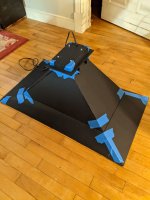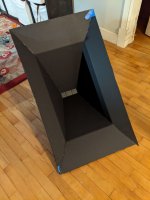Hi WBS,
I noticed in the data sheet spec that SEAS included a response adjustment to attenuate the high frequency output using an inductor and resistor. Anyways, I guess you took care of that with the EQ.
Happy listening!
I noticed in the data sheet spec that SEAS included a response adjustment to attenuate the high frequency output using an inductor and resistor. Anyways, I guess you took care of that with the EQ.
Happy listening!
yatr98, Whereas the high frequency attenuation suggested by Seas attenuates the high frequencies, this EQ improves the bass as well. 🙂
If one were to suggest an obtainable constrained layer for such a doubled up layup -
....
Perhaps the foamcore could be turned into a metamaterial by constraining a layer of somethin' between, with even better properties than just the two boards.
"A sandwich panel is any structure made of three layers: a low-density core, and a thin skin-layer bonded to each side. Sandwich panels are used in applications where a combination of high structural rigidity and low weight is required.
The structural functionality of a sandwich panel is similar the classic I-beam, where two face sheets primarily resist the in-plane and lateral bending loads." There are lot of houses built with SIPs (Structural Insulated Panel) all over in the world.
But I finally asked myself just how much effort I wanted to put into a trial concept.
You said they sound almost good 'enuff that you're in no hurry to go for the wood. Just wondering what it would take to not (have to, want to) go for the wood at all?
I terms of how it sounds, of course. I too love a real wood grain finish!
why can't it simply be the glue between the two "pFp" layers?
Well, a couple of the thoughts were a dense elastomer as the glue between. Just thinkin' outside the "box".
"A sandwich panel is any structure made of three layers: a low-density core, and a thin skin-layer bonded to each side
Wonder what happens when you use a high density core, like rubber in between?
You said they sound almost good 'enuff that you're in no hurry to go for the wood. Just wondering what it would take to not (have to, want to) go for the wood at all?
I terms of how it sounds, of course. I too love a real wood grain finish!
If I had a table saw I would've started with wood.
Today I had them cranked up pretty loud and noticed the foam core boxes weren't completely dead. I'm certain that wood properly braced and stuffed would tighten up the bass considerably. For the next phase of the project I'm thinking about designing an aperiodic box of the same volume.
I only need three things now. First; clear out some room in the garage. Second; find a great deal on a table saw. Third; convince my wife that I need one. 😀
Wonder what happens when you use a high density core, like rubber in between?
Rubber is elastic, while polystyrene is not. If the outer material is also elastic, one can make curved walls with such a composite. Usually, a composite material is much tougher than the used materials separately, for example SIPs.
If I do another build I am thinking foam core then covering with ¼" plywood (or wood).You said they sound almost good 'enuff that you're in no hurry to go for the wood. Just wondering what it would take to not (have to, want to) go for the wood at all?
I terms of how it sounds, of course. I too love a real wood grain finish!
i wonder if something like model airplane stuff like monokote could be used to finish a foamcore speaker...maybe not...the heat shrink process may not play nice with the foamcore...
I'm pretty sure the Monocote adhesive requires a low enough temp to stick without damaging the paper cover of the foam core. It would be interesting to try!
i know Monokote or at least the types i've used are like shrink wrap in that heat changes it's size which i was thinking would put the foamcore under tension raising the resonant point, but the heating might be an issue.
They do have Ultrakote and it needs less heat than Monokote.
A few years back I covered a foam plane with tissue paper and water based polyurethane, once it dried I lightly sanded then coated with just the poly and it was hard and strong but very light and a much better surface to paint. You might need to seal the edges of the paper covered foam to prevent any lifting though.
A few years back I covered a foam plane with tissue paper and water based polyurethane, once it dried I lightly sanded then coated with just the poly and it was hard and strong but very light and a much better surface to paint. You might need to seal the edges of the paper covered foam to prevent any lifting though.
I’m going to have 4 unused CSS EL70 drivers soon and think I may try a build of microTowers or MTMs out of XPS or layered foamcore.
Here’s an old MTM crossover for EL70s:
Would this work?
I have some ApexJr $1 Audax poly dome tweeters.
$1 Apex Jr tweeter????
Could be an interesting experiment.
Here’s an old MTM crossover for EL70s:
Would this work?
I have some ApexJr $1 Audax poly dome tweeters.
$1 Apex Jr tweeter????
Could be an interesting experiment.
Yes, a simple XO with cap and resistor for tweeter and inductor for EL70 can work probably. Adason did a MTM with TC9 and 1in fabric dome tweeter.
MTM with TC9fd
MTM with TC9fd
I've been musing over a couple of designs recently, and then I discovered this thread showing off how the GRS 8" planar driver loads well into a horn.
After a brief chat with @xrk971 , I decided to go ahead and use @bwaslo 's spreadsheet to create a 250Hz horn, and then stretch the vertical dimension to accommodate for the rectangular shape of the driver.
I was told that the back chamber could be small, so I made it 6.5" wide, 10" tall and 1" deep.
I had some 1.75" machine bolts and nuts at hand, which allowed me to not only bolt the driver to the throat flange, but also bolt the rear chamber to the flange as well, which made life simpler - all I needed were 4 bolts and 8 nuts for each horn.
I've done a little bit of listening with them as a stereo pair, and they're very pleasant to listen to. Very accurate without sounding 'cold', and the transient response is fantastic. I did get the sensation of being enveloped in sound again, similar to that headphone effect, and the stereo separation was really accurate and created a very detailed image.
My crossover to my Bass speakers was a little high at 400Hz, so I'm not sure if I was missing any information, but I'm going to sort it out so that the crossover is at 250Hz.
All in all a quick build with a really good result. Highly recommended! 🙂
After a brief chat with @xrk971 , I decided to go ahead and use @bwaslo 's spreadsheet to create a 250Hz horn, and then stretch the vertical dimension to accommodate for the rectangular shape of the driver.
I was told that the back chamber could be small, so I made it 6.5" wide, 10" tall and 1" deep.
I had some 1.75" machine bolts and nuts at hand, which allowed me to not only bolt the driver to the throat flange, but also bolt the rear chamber to the flange as well, which made life simpler - all I needed were 4 bolts and 8 nuts for each horn.
I've done a little bit of listening with them as a stereo pair, and they're very pleasant to listen to. Very accurate without sounding 'cold', and the transient response is fantastic. I did get the sensation of being enveloped in sound again, similar to that headphone effect, and the stereo separation was really accurate and created a very detailed image.
My crossover to my Bass speakers was a little high at 400Hz, so I'm not sure if I was missing any information, but I'm going to sort it out so that the crossover is at 250Hz.
All in all a quick build with a really good result. Highly recommended! 🙂
Attachments
Nice work! That looks sweet. Does it get loud but stays clean? I would cross closer to 700Hz.
- Home
- Loudspeakers
- Full Range
- Foam Core Board Speaker Enclosures?

